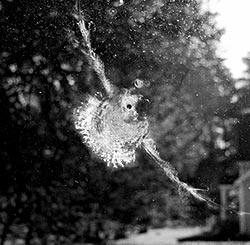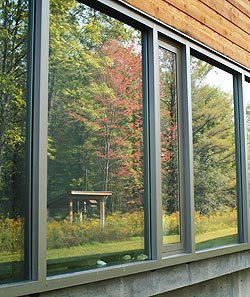How To Avoid Birds Hitting Windows
For birds, glass windows are worse than invisible. By reflecting foliage or sky, they look similar inviting places to fly into. And because the sheer number of windows is so slap-up, their toll on birds is huge. Up to nearly 1 billion birds die from window strikes in the U.South. each year, co-ordinate to a 2014 report.
The good news is that you can greatly reduce the danger your home's windows pose to birds with some unproblematic remedies, according to Christine Sheppard, who directs the Bird Collisions Programme of the American Bird Conservancy. The grouping offers extensive information on preventing collisions on its website. The Fatal Light Awareness Programme also offers great information on preventing bird collisions.
What happens to birds that hit windows? Sadly, the bird ofttimes dies, fifty-fifty when it is only temporarily stunned and manages to wing away. Many times these birds die subsequently from internal bleeding or bruising, especially on the brain. Daniel Klem of Muhlenberg College has researched this issue since the 1970s. He writes, "Drinking glass is an indiscriminate killer that takes the fit likewise as the unfit of a species' population."

The window banner left past a Mourning Dove. Photograph by Priscilla Bradley/PFW.
Why Birds Collide With Windows
At that place are two main types of window collisions: daytime and nighttime. In daylight, birds crash into windows because they see reflections of vegetationor see through the drinking glass to potted plants or vegetation on the other side. At night, nocturnal migrants (including nearly songbirds) crashbecause they fly into lighted windows.
For reasons not entirely understood, lights divert nocturnal migrants from their original path, especially in depression-ceiling or foggy conditions. In the lighted area, they mill nearly, sometimes colliding with one another or the lighted construction. As a subsequent hazard, migrants fatigued off course past urban lighting may roost safely nearby, only to become vulnerable to daytime reflections in windows the following twenty-four hours. The BirdCast project and the Fatal Low-cal Awareness Programme have more nigh this problem.
In that location'due south one additional reason: birds sometimes see their reflection in a window and assault it. This happens most frequently in the leap when territoriality is high. Although it can be abrasive to the homeowner, information technology'south seldom a threat to the bird's survival. Most of the remedies suggested below for window strikes will besides aid solve the problem of a bird attacking its reflection.

Reflected landscapes can misfile birds and cause deadly window strikes. Photo by Susan Spear/Cornell Lab.
How to Safeguard Your Windows For Birds
Start by identifying unsafe windows, including large picture windows, paired windows at right angles to each other, or windows with feeders outside. Go outside and look at your windows from a bird'due south point of view. If you see branches or sky reflected in or visible through the glass, that'south what the birds will see, likewise. By recommendations about prophylactic distances for feeders outside windows are no longer thought to be valid, Sheppard says. "If you've got windows virtually a bird feeder, yous should make them bird friendly and don't worry about how far away they are."
Treatments for Existing Windows
To deter small-scale birds, vertical markings on windows demand to be spaced no more than 4 inches autonomously and horizontal markings no more than than ii inches apart across the entire window. (If hummingbirds are a problem, the spacing should be reduced to a ii-inch by 2-inch grid.) All marking techniques should exist practical to the outside of the window.
- Tempera pigment or soap. Marking the outside of the window with soap or tempera pigment, which is cheap and long lasting. You tin use either a grid design no more than four inches by ii inches (come across above), or get creative and paint patterns or artwork on your window.
- Decals. Put decals, stickers, sun catchers, mylar strips, masking tape, or other objects (even mucilaginous notes) on the exterior surface of the window. These are but effective when spaced very closely (meet higher up).Note that hawk silhouettes do little to deter birds. Think: placing just ane or two window stickers on a big window is not going to forbid collisions—they must embrace most of the glass with the spaces between besides narrow for birds to fly through.
- Dot Patterns and Tape. Long-lasting tape products offer an easier way to apply the correct spacing of dots across your window. More about bird tape.
- Acopian Bird Savers.Also known equally "zen curtains," these closely spaced ropes hang down over windows. They do the work of tape or decals but are easier to install and can be aesthetically pleasing. You tin can order them to fit your windows or brand your own.
- Screens. Installing mosquito screens over your windows is very effective, equally long equally they are on the outside of the window and cover the unabridged surface.
- Netting. Cover the glass on the exterior with netting at least 3 inches from the glass, taut enough to bounce birds off before they hit. Small-scale-mesh netting (around 5/viii″ or i.6 cm) is best, so that birds don't get their heads or bodies entangled but will bounciness off unharmed. You can mount the netting on a frame, such as a storm-window frame, for easy installation and removal.
- One-way transparent pic. Products such as Collidescape permit people on the within to meet out, simply makes the window appear opaque on the outside. They can reduce the amount of calorie-free that comes in your window (this can also reduce your cooling costs), according to Sheppard.
New Homes and Remodels
- Install external shutters and keep them closed when you're not in the room or taking advantage of the low-cal or view. (These can be huge energy savers, too!)
- Install external lord's day shades or awnings on windows, to cake the reflection of sunlight. Remote controlled shades are available.
- On new construction or when putting in new windows, consider windows that have the screen on the entire outside of the glass.
- Add interior vertical blinds and go along the slats merely one-half open.
- Avoid visual paths to sky and greenery. Bright windows on the opposite wall from your picture window may give the illusion of an open path to the other side. Closing a window shade or a door between rooms can sometimes solve this situation.
Lights Out
Lights Out initiatives are gaining footing in U.S. cities including Dallas, Houston, Philadelphia, and New York. The all-nighttime glow of office buildings and streetlights in cities is especially dangerous for cartoon migrating birds off course, delaying their migrations and making them vulnerable to window collisions. Turning off nonessential lights and installing down-facing lighting are relatively simple ways to reduce the trouble of artificial light at night. It's even so wise to take precautions against window collisions using whatsoever of the above methods, especially for homeowners.
Source: https://www.allaboutbirds.org/news/why-birds-hit-windows-and-how-you-can-help-prevent-it/
Posted by: coledisme1997.blogspot.com

0 Response to "How To Avoid Birds Hitting Windows"
Post a Comment